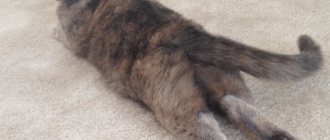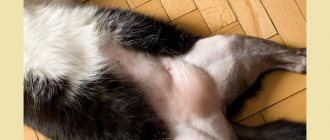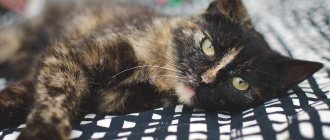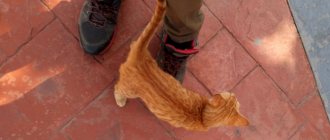Weakness in a cat's back legs is a clear sign that something is wrong. There are many reasons why this weakness can occur in the hind legs of animals and is often accompanied by other symptoms.
If you've come this far in your search for information, it's because you're concerned about your pet's health.
If so, we invite you to read the information we have compiled for you about hind leg failure in cats. In any case, always remember that a specialist’s opinion is necessary in this case. If you are concerned about your cat's health, we recommend that you take her to a veterinarian.
Causes of hind leg failure
A cat with pain or numbness in its limbs is a lethargic, weak animal with no appetite that spends the entire day lying down. The impairment can range from simple pain that limits freedom of movement to complete paralysis, tremors and seizures.
Since this symptom can be multifactorial, we decided to list for you the main reasons why cats' hind legs fail.
© shutterstock
Although being run over, getting into a fight, or falling can cause immobility, there are medical conditions that are more difficult to diagnose and have a less optimistic prognosis. These diseases include the following:
- Constipation:
Constipation, which is more common in cats with kidney disease, affects not only the digestive system, but also the lower back. This is why the hind legs lose strength and mobility.
If this situation persists for several days and is accompanied by vomiting and loss of appetite, you should make an appointment with your veterinarian as soon as possible to have your cat examined. Keep in mind that if the problem is chronic constipation, it can cause permanent damage to the liver, intestines and kidneys. In these cases, it is an issue that should not be taken lightly.
- Hip dysplasia:
This is one of the main reasons why dogs drag their paws. However, it is not such a common condition in cats.
In felines, hip dysplasia tends to run in families and is related to race.
It affects the hip bones from a very early age due to the fact that a defect occurs in the joint of the hip joint, which increases over the years due to wear and tear of the bones and friction.
Due to the fact that the hip and pelvic bones do not develop properly, cats experience constant pain, limited movement and eventually lead to osteoarthritis.
You should know that once your veterinarian diagnoses you with this condition, the problem will not go away because hip dysplasia is a degenerative and irreversible process that will deteriorate your cat's health over time.
This pathology is more common in large cats, such as the Norwegian Forest Cat or Maine Coon, with females being most affected.
- Thrombosis:
Thrombosis is a blood clot stuck somewhere in the body. In cats, the hips and paws are affected because blood does not flow normally to these areas and therefore their mobility is reduced.
In cats, the disease is known as stool thrombus, feline aortic thromboembolism. This condition is not as common in dogs as it is in cats.
Thrombus in the stool disease is characterized by damage to both one and both hind limbs. The paws become cold and the nerves and muscles become stiff and inflamed due to lack of oxygenation. Unfortunately, this is a life-threatening anomaly.
Renal failure is the main, but not the only cause of thrombosis. If you have questions, consult your veterinarian.
- Hypertrophic cardiomyopathy:
This is coronary heart disease, characterized by thickening of the walls of the heart.
This condition causes blood to not reach certain parts of the body, such as the hind legs and tail, because they are further away from the heart.
Hypertrophic cardiomyopathy can eventually lead to paralysis of the limbs, either completely or partially, due to lack of blood supply.
© shutterstock
- Spinal injuries:
Damage to the spinal cord can paralyze any animal. Cats are very flexible, in fact, they do not have collarbones, they fit into any hole, no matter how small it is. Consequently, injuries are very common among cats.
A veterinarian diagnoses the disease using an X-ray or MRI. Depending on your specific situation, your doctor can decide whether to proceed with surgery, medications, or rehabilitation.
- Feline panleukopenia:
This is a very dangerous viral disease that is spread through urine, feces and fleas and spreads between unvaccinated cats.
This disease leaves the animal with effects that make it difficult for them to move, they cannot stand up completely, they lift their legs to be able to move, and they easily lose their balance.
Although in this case the hind legs do not completely fail, it does affect mobility.
- Diabetes:
Increased blood glucose levels and decreased potassium levels cause certain neurological disorders that most often affect the extremities.
Other possible diseases:
Other reasons why a cat’s back legs fail:
- Cancer
- Leukemia
- Feline immunodeficiency virus
- Osteoporosis
- Herniated discs
- Spinal cord injuries
- Osteoarthritis
Why does the animal limp, although there are no visible injuries or obvious causes?
Sometimes it happens that a cat limps from time to time, but there are no visible signs, as well as obvious causes of lameness. In this situation, only a veterinarian can understand why the pet began to limp on the front or back leg. This may be due to diseases of the joints, bone tissue, neoplasms, problems with the spine, and the consequences of infections.
What to do
It must be emphasized that when cats' back legs begin to fail, it means that something is happening to their body, and it can be quite serious.
Causes can range from simple constipation to cancer and fracture. Whatever the origin of the disease, only a veterinarian can make the correct diagnosis and possible treatment.
You can examine their feet, toes, pads, and nails for damage. While you are investigating the cause of the disease, keep an eye on where it lies to prevent it from getting worse. Make sure there are no dangerous items or toxic substances in the environment that could worsen the condition.
Once the diagnosis is confirmed, your role will be to give him enough attention and care so that he recovers as quickly as possible.
Diagnosis of lameness
For the owner, any change in habitual behavior can be a reason to closely monitor the pet. We tend to think that lameness is easy to notice, but cats are special animals and this is not true for them. A limping cat can masterfully transfer its body weight to healthy limbs, and outwardly its movement will remain virtually unchanged. Therefore, the first signs of lameness can be considered changes in the cat’s activity:
- decreased activity, the cat sleeps more and plays less;
- lack of jumping activity, if they were there before;
- searching for shelter, a secluded place, previously not typical for a cat;
- deterioration in the condition of the coat due to difficulties with self-grooming - due to a sore paw or the inability to turn around, the cat may have difficulty grooming its coat.
In chronic pathologies, such symptoms can increase gradually, as a result of which the owner seems to think that everything is normal, sometimes this is associated with age-related changes. However, despite the seeming harmlessness, this is a reason to take your cat to the doctor and make sure that he is not in pain for any reason. If you see that your cat is limping, dragging its paws, placing them incorrectly, has an unsteady gait, or tremor (trembling) of its limbs, this is a reason to urgently consult a veterinarian.
The primary diagnosis of lameness consists of a physical examination by a doctor, taking a medical history, and conducting an orthopedic or neurological examination. Further diagnosis will depend on the results of the examination.
First aid at home
Before you take the victim to the veterinary clinic, you need to take a few simple steps:
- Calm the animal. If paw failure occurs suddenly, the cat will inevitably experience stress - it needs to be relieved with kind words and the creation of a quiet atmosphere around.
- Check the temperature of the paws - if they are cold, place a heating pad or a bottle of hot water under them. It is better to wrap it in a towel - this way the animal will not get burned.
- If you are sure that the cause is not injury, place your pet in a soft-covered carrier.
- For injuries to the paws or spine, on the contrary, a hard and flat surface is needed. If possible, you need to immobilize the cat - but so that he does not get nervous. Perhaps on the way to the clinic it is enough to hold him on top with your hands.
- With viral or bacterial infections, the animal may vomit and diarrhea is possible. In such cases, it is necessary to lay the cat on its side so that it does not choke, and put a disposable diaper on it.
When going to the veterinary clinic, do not panic. Take a syringe without a needle with water (if the animal wants to drink), a veterinary passport, a change of clean diaper, and wet wipes. If it's cold outside, take care of a light but warm blanket.
Prevention
Lameness occurs during normal daily activities. Severe injuries such as falling from a height or being hit by a car can be avoided by keeping your cat indoors.
Cats should eat a carefully balanced diet to ensure a strong and healthy skeleton. If feeding homemade food, consult a veterinary nutritionist who can help you choose the right diet with all the necessary vitamins and minerals for your cat's health.
Avoid obesity in your pet.
At the first sign of lameness on the front legs, consult your veterinarian!
Sources
- https://gafki.ru/koshki/khromaet-na-zadnyuyu-lapu-bez-vidimykh-povrezhdeniy.html
- https://kinpet.ru/u-koshki-otnimayutsya-zadnie-lapy-naskolko-vse-serezno/
- https://vashipitomcy.ru/publ/zdorove/bolezni/khromota_u_koshki_osnovnye_prichiny_provocirujushhie_nedug/15-1-0-1998
- https://animashka.info/koshki-uhod/kotenok-ushib-lapku-hromaet.html
- https://zoostatus.ru/lechenie/simpromy/khromota-u-koshek/
- https://dr-pets.ru/stati/hromota-u-koshek-i-sobak.html
[collapse]
Drug treatment
If paresis of the limbs is confirmed, appropriate drug therapy is selected for the cat. Depending on the disease that caused the paralysis, various drugs are used. They can be presented:
- antibiotics to relieve inflammation caused by infection;
- vitamins to strengthen the immune system;
- drugs that thin the blood for thrombosis and stroke;
- anti-mite drugs;
- diuretics.
The treatment regimen may differ depending on the underlying disease that caused the failure of the cat's hind legs.
Predisposing factors and how to combat them
Currently, not everything is known about the causes of arthritis. It has many varieties, among which it should be noted: osteoarthritis, gout and rheumatoid arthritis . Each type has its own characteristic features, but at the same time, there is also a lot in common between them: pain when moving, severe lameness, inflammatory processes. The latter (in especially advanced cases) can lead to the development of sepsis and complete destruction of the joints.
There is also “occupational” arthritis. This type of pathology is characterized by the fact that pathological changes in the joints occur as a result of many years of repeated stress on the limbs. For example, chronic arthritis can occur (due to the specifics of the “profession”) in circus cats. But this, of course, is truly exotic. Much more often, the causes of arthritis and the lameness it causes are much more commonplace.
Often the disease is provoked by a cold infection, severe bruises and bites in the joint area , and constant contact with toxic substances. Sometimes an exclusively fish or “dry” (that is, the cat is fed only dry food) diet contributes to joint disease. Rare cases of psychosomatic arthritis appearing in particularly sensitive pets against the background of serious stress (after sterilization, for example) have been described.
How does the disease manifest? The cat begins to limp heavily, every movement causes her severe pain. The joints may become noticeably swollen, and when palpated, it is easy to notice an increase in local body temperature. As a rule, animals react aggressively to attempts to probe them: they meow hoarsely, try to scratch the owner and run away.











